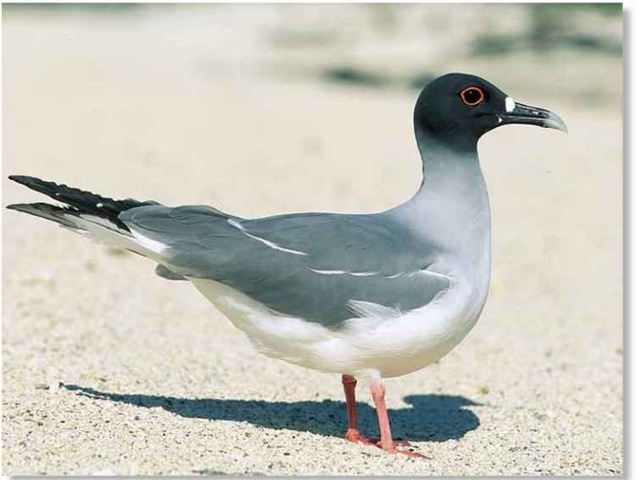ORDER
Charadriiformes
FAMILY
Laridae
GENUS & SPECIES
key features
Emits an eerie sound, a cross between a snore and a scream
Like a bat, finds food through echolocation with the help of a clicking call
white markings on its bill make the bird more visible at night to its young chicks
where in the world?
Breeds on Galapagos islands; also inhabits
Malpelo island off Colombia and eastern South America from Panama to Peru

LIFECYCLE
The gull forms loose colonies during breeding seasons: close neighbors often synchronize egg laying. One bird’s displays stimulate a chain reaction among other mating pairs.
HABITAT
The swallow-tailed gull is equally at home on cliffs, sand and rough lava deposits. Cliff ledges appear to be the gull’s most successful breeding ground and nesting habitat. It frequents all of the Galapagos Islands, except Fernandina. After breeding in the Galapagos, the gulls fly east into Ecuador and Peru. Some occasionally travel into Panama.

A Daytime glide
The swallow-tailed gull migrates from breeding grounds in the Galapagos to winter homes in Ecuador and Peru.
During moments of anxiety, the swallow-tailed gull shows its tongue.
On the Galapagos Islands, the birds’ piercing alarm calls greet visitors.
The Galapagos short-eared owl preys on swallow-tailed chicks, but as a protected area, the Galapagos Islands offer a relatively safe environment for the gull.
BREEDING
The swallow-tailed gull breeds in loose colonies but sometimes seeks solitude on gravel beaches and cliff slopes on the Galapagos Islands. Courtship includes calls and the male offering the female pebbles for the nest and regurgitated fish or squid. Males choose the nesting site along the rocky cliffs and shores.As lifetime mates, both sexes are extremely loyal and territorial, with the female often flying alongside the male.The nest consists of up to about 300 small pebbles with a depression in the middle. Breeding pairs within small social groups often synchronize nest-building and egg-laying. A “leader” pair begins to build a nest and lay the single egg, and other gulls follow their example. Both parents incubate for about 35 days; the newly hatched chick weighs about 1.5 oz. and is gray and fluffy with black markings.The chick pecks at the white spot on its parent’s bill when begging for food at night, and receives regurgitated food for its efforts.
AND BABY MAKES THREE

Maximum attention…
One parent leaves the cliffside nest in search of food while the other watches over the chick.
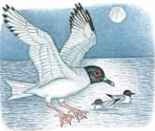
Nightly feed…
The parent joins two other gulls in their nightly search on the surface of the calm sea.
FOOD & HUNTING
With its long bill poised, the swallow-tailed gull searches for fish and squid near the water’s surface after sunset, usually flying about 10-20 miles offshore. It may also snatch squid and fish in the wake of motor boats cruising near the Galapagos Islands.The gull has keen eyesight — the eye’s oil droplets enhance the prey’s coloration in the water. The gull also uses a variety of vocalizations to locate its food. The calls are similar to sounds used for echolocation, creating sounds that echo back to the ears and help to pinpoint swimming prey. Juveniles use the white spot on the adult’s bill as a focal point when begging for food; the white is like a beacon in the night.
Nighttime meal The swallow-tailed gull uses its long bill to snatch snacks from the sea.
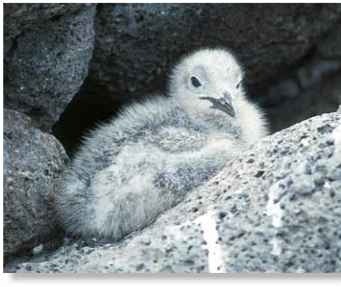

Bullseye…
The swallow-tailed gull, using its keen eyesight, spots large squid propelling through the water.
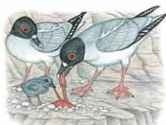
Back home
The swallow-tailed chick anxiously waits for its parent to finish regurgitating its meal.
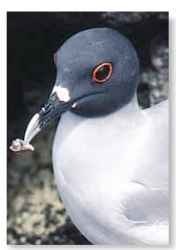
CONSERVATION
With a total population of 10,000-15,000 pairs, the swallow-tailed gull is not endangered. However, there have been periodic food shortages that affect the swallow-tailed gull population, and sometimes survival rates of hatchlings are low because of predators, such as owls.
BEHAVIOR
The gull defends strictly defined territories; consequently, as long as approaching birds remain on the right side of the boundary, they will be tolerated, even though they may be quite near. A variety of calls are used to announce and defend the territory; the swallow-tailed gull has a rather un-gull-like vocal repertoire, which includes snoring, rattling, screaming and whistling sounds.Territorial fights are infrequent and not very violent, but when trespassing occurs, the males will twist each others’ bills. After an aggressive encounter, males often make a display flight above their territory, flying buoyantly with slow, floating wing beats, much like a butterfly. In another territorial display, the bird remains aloft momentarily with its wings held up, and then assumes a pose with the bill pointing up, neck retracted.The gull makes swift up-and-down pumping movements with the head, while calling out gutturally. It is usually fol-owed by a sudden downward jerk of the head, with the gull looking at its k feet as if to say, “this spot is mine.”
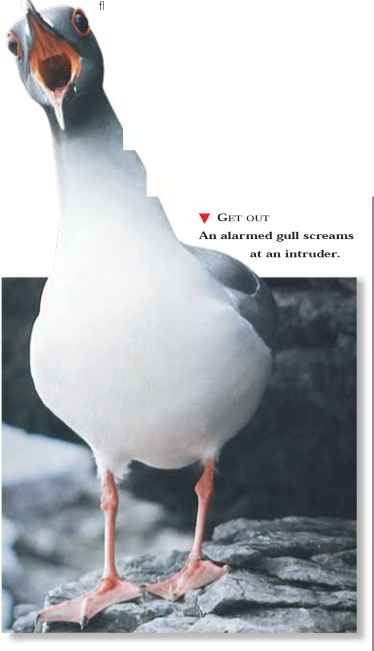
PROFILE
Swallow-tailed Gull
The swallow-tailed gull is most active at night, staring intently into the sea with its crimson-ringed eyes in search of squid and fish.
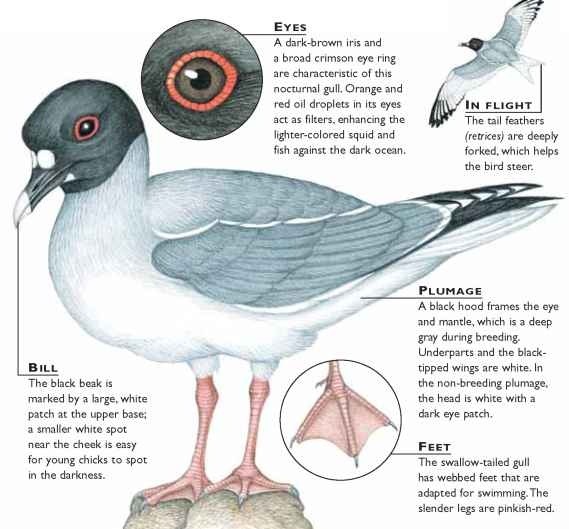
CREATURE COMPARISONS
At 13″ Sabine’s gull (Larus sabini) is about half the size of the swallow-tailed gull. Unlike its South American cousin, Sabine’s gull breeds near the coasts of Alaska, northern Canada, Greenland, Russia and Siberia. Both gulls search for fish, which they snatch from the upper surface of the sea.The heads of both gull species remain white during nonbreeding seasons, but during breeding the Sabine’s hood is mostly gray, while the swallow-tail’s is almost black from the nape to the throat.The gulls’ wings are similar; with alternating shades of white, gray and black.
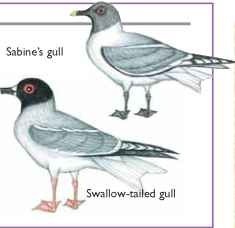
vital |
|
| statistics | |
| Length | 22″ |
| Wingspan | 52″ |
| Sexual Maturity | 1-2 years |
| Breeding Season | Throughout 1 the year; depends on region |
| Number of Eggs | 1 |
| Incubation Period | 34-35 days |
| Fledging Period | 58-65 days |
| Breeding Interval | Up to 10 months |
| Typical Diet | Squid, fish |
| Lifespan | About 5-18 |
| years | |
Related species
• The swallow-tailed gull is one of 43 species of gull in the world. It is the only species in its genus, Creagrus. Close relatives in the genus Larus include the Bonaparte’s gull, L. Philadelphia, and the California gull, L. californicus. The family Laridae includes both gulls and terns. Gulls and terns are closely related to the skuas, jaegers and skimmers in the order Charadriiformes.
